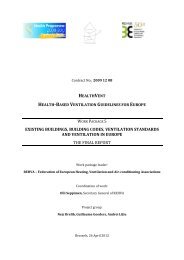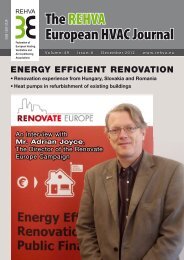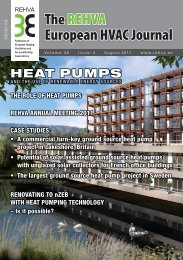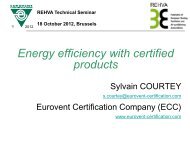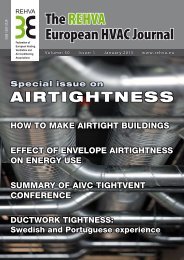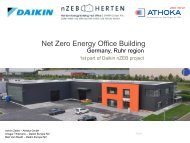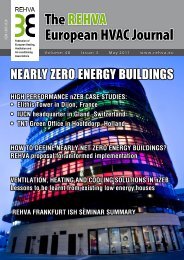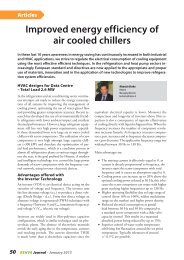CO2 Heat Pumps in Europe Market Dynamics & Legislative ... - shecco
CO2 Heat Pumps in Europe Market Dynamics & Legislative ... - shecco
CO2 Heat Pumps in Europe Market Dynamics & Legislative ... - shecco
Create successful ePaper yourself
Turn your PDF publications into a flip-book with our unique Google optimized e-Paper software.
<strong>Market</strong> reports<br />
With regard to market policy conditions 63% of participants<br />
believe the bus<strong>in</strong>ess and policy climate for<br />
CO 2 <strong>in</strong> <strong>Europe</strong> to already be “rather” or “very” positive.<br />
(Figure 3)<br />
QUESTION:<br />
“How is the Bus<strong>in</strong>ess and Policy Climate evolv<strong>in</strong>g <strong>in</strong><br />
your country (location of organisation)?”<br />
Ammonia<br />
46%<br />
50%<br />
33%<br />
Hydrocarbons 45%<br />
41% 40%<br />
40% CO 2<br />
37%<br />
34%<br />
NR overall<br />
30%<br />
29%<br />
5%<br />
14%<br />
20%<br />
17%<br />
18%<br />
2%<br />
11%<br />
10%<br />
9%<br />
5%<br />
3% 4% 3%<br />
4%<br />
0%<br />
Highly<br />
Negative<br />
Rather<br />
Negative<br />
Not<br />
Mov<strong>in</strong>g<br />
<strong>in</strong> Any<br />
Direction<br />
Rather<br />
Positive<br />
Benefits of CO 2 heat pump water<br />
heaters (HPWH)<br />
Highly<br />
Positive<br />
Figure 3. <strong>Market</strong> and Policy Environment of Natural<br />
Refrigerants <strong>in</strong> <strong>Europe</strong>. Responses of 1338 <strong>in</strong>dustry<br />
experts. [1]<br />
HPWHs are a relatively mature technology and have<br />
ga<strong>in</strong>ed popularity over the past decade with<strong>in</strong> the water<br />
heat<strong>in</strong>g <strong>in</strong>dustry because of their ability to deliver significantly<br />
more heat for the same amount of electricity<br />
compared to traditional electric storage water heaters<br />
(SWH).<br />
The CO 2 heat pump water heater cycle is transcritical,<br />
operat<strong>in</strong>g at much higher temperatures and pressures<br />
than conventional subcritical cycles. The transcritical<br />
cycle operation provides a large cont<strong>in</strong>uous temperature<br />
glide and can offer a higher service temperature with<br />
limited capacity loss.<br />
CO 2 heat pumps <strong>in</strong>stallations <strong>in</strong><br />
commercial applications <strong>in</strong> <strong>Europe</strong><br />
Today most of the CO 2 heat pumps are designed for<br />
Domestic Water <strong>Heat</strong><strong>in</strong>g (DWH), with Japanese companies<br />
like Panasonic, Daik<strong>in</strong>, DENSO, Sanden, Itomic<br />
and Mitsubishi some of the most active promoters of the<br />
technology. Whilst the Japanese market can be considered<br />
mature, CO 2 heat pumps represent a niche market<br />
<strong>in</strong> <strong>Europe</strong>. However, more and more Japanese companies<br />
are enter<strong>in</strong>g the <strong>Europe</strong>an market, redesign<strong>in</strong>g their<br />
CO 2 heat pumps to fit the <strong>Europe</strong>an way of life, climate,<br />
hous<strong>in</strong>g structures as well as EU and national energy and<br />
safety standards.<br />
Local CO 2 heat pump manufacturers are also emerg<strong>in</strong>g,<br />
with companies like Stiebel, enEX, ICS, Thermea,<br />
Kylma, CTC, JCA, and Viessmann add<strong>in</strong>g CO 2 heat<br />
pumps to their product ranges.<br />
Outside the domestic market, commercial real estate<br />
owners are beg<strong>in</strong>n<strong>in</strong>g to see CO 2 heat pumps as a promis<strong>in</strong>g,<br />
high performance option for high temperature<br />
sanitary hot water for hotels, restaurants, hospitals,<br />
schools and other public build<strong>in</strong>gs. Evidence of this can<br />
be seen <strong>in</strong> some most recent examples of commercial applications<br />
of CO 2 heat pumps <strong>in</strong> <strong>Europe</strong>:<br />
Denmark: A large scale 100% renewable energy project<br />
that provides the Danish city of Marstal with a largescale<br />
district heat<strong>in</strong>g system <strong>in</strong>corporates a 1.5 MW<br />
thermally CO 2 driven heat pump. The project, developed<br />
with a grant from the EU’s Seventh Framework<br />
Programme (FP7), <strong>in</strong>cludes a solar plant, a comb<strong>in</strong>ed<br />
heat and power (CHP) system, an Organic Rank<strong>in</strong>e<br />
Cycle (ORC) Unit and a 75 000 m³ pit for heat storage,<br />
with the CO 2 heat pump mov<strong>in</strong>g energy to the energy<br />
storage pit.<br />
Ireland: Ecocute Innovation and Design Limited<br />
(Ecocute Ltd) has <strong>in</strong>stalled an air to water transcritical<br />
CO 2 heat pump (TCHP) water heat<strong>in</strong>g system to supplement<br />
the O’Donovan’s Hotel’s exist<strong>in</strong>g solar thermal<br />
system. The Hotel’s domestic hot water is now supplied<br />
by a 25 kW transcritical CO 2 heat pump that can<br />
operate at a seasonal performance factor of 3.2 when<br />
generat<strong>in</strong>g hot water at 75°C <strong>in</strong> Irish ambient conditions<br />
of 9.4°C air temperature and 10°C water <strong>in</strong>let<br />
temperature.<br />
Also <strong>in</strong> Ireland, the Cúil Díd<strong>in</strong> Residential and Nurs<strong>in</strong>g<br />
Care Facility <strong>in</strong> Tralee county Kerry has <strong>in</strong>stalled a transcritical<br />
CO 2 heat pump to supply hot water for the<br />
laundry facilities, kitchens and for the care of the residents.<br />
The new CO 2 heat pump can produce 2 500 litres<br />
of hot water per night at 90°C, which is able to meet<br />
the hot water demand 24 hours a day. Overall, cost sav<strong>in</strong>gs<br />
of 70‐80% are expected.<br />
France: A McDonald’s <strong>in</strong> France <strong>in</strong>stalled a CO 2 heat<br />
pump produced by Panasonic to comply with the energy<br />
and emission reduction priorities for new and exist<strong>in</strong>g<br />
build<strong>in</strong>gs <strong>in</strong> the French government’s Grenelle<br />
REHVA Journal – October 2012 51




